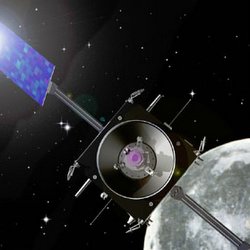Summary of the lecture of Prof. Bernard Poing, the chief scientist in the Smart-1 project at the Valencia Space Congress
Tal Inbar, Valencia, special to the science site

Escape from Earth's orbit, reaching the Moon, descending to an orbit suitable for scientific photography (400 to 3,000 km) in March 2005, updating the orbit to extend the mission until August 2006, and all this using solar energy and the help of 60 liters of the material Xenon, for the purpose of carrying out The maneuvers. The Smart-1 instruments, which represented new technologies, revealed many clues about the origin of the moon, its composition, mineralogy, geology, as well as collisions of bodies from space, volcanic activities and tectonic processes that shaped the moon. Smart-1 gave us a new look at the poles, far side regions and sites of interest for future robotic and manned missions, and made measurements in preparation for the fleet of orbiters planned to reach the moon.
Smart-1 used thrust boosters, which will also allow a controlled crash on the near side of the moon in the last month. We described the last actions that made possible the attack on the exact date - September 3, 2006, and even the exact hour, minute and second and the exact location in the Lake of Excellence. The lecture also describes the impact of the global campaign on the fiber project and the operational team, the theoretical analysts, the simulations in the laboratory, astronomical observations, listening to the spacecraft using the broad-based radio array, amateur astronomers, the public and the media events organized to celebrate the landing of Smart-1 on the lunar soil.
Following the events in real time, we will report on the current status of data from the spacecraft, and observations from Earth of the flash, and the clouds of dust and debris created as a result of the impact. We taught a lesson to prepare the operations of spaceships, impact spacecraft and future lunar landers.
* Tal Inbar participates in the Space Congress as a representative of the Fisher Institute for Strategic Studies of Aviation and Space.
